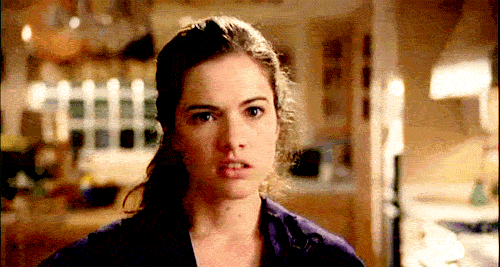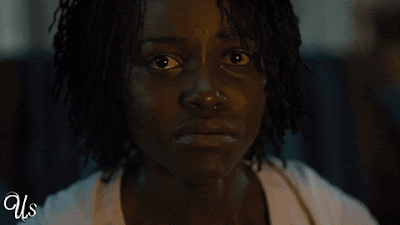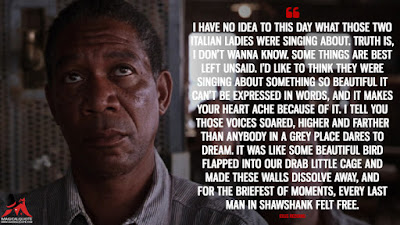When it comes to different genres of film, everybody has their likes and dislikes, just as they do with music they listen to, shows they watch or stream, or the kinds of foods they eat. That being said, not everybody likes today's comedy--most of it, at least. And not everybody is waiting in line for the next Nicholas Sparks novel. And not everybody thinks Marvel movies qualify as "cinema". (Just ask esteemed filmmakers Martin Scorsese and Francis Ford Coppola.)
It's just that some genres or the like are more challenging to talk about than others.
Take horror, for example. Often associated with blood, gore, monsters and/or occult-like images, this particular genre (which has been around as long as fantasy, comedy, and drama) has been a difficult topic among discerning or sensitive viewers, critics, and readers. For one thing, one of its criticisms has been a lack of redemptive qualities in its stories and/or characters, and rather on "survival of the fittest" notions, such as when said characters are trying to outsmart either the razor-sharp nightmares of a sweater-/fedora-wearing boogeyman, or the grisly body counts of a hockey-masked, machete-wielding killer, or the twisted puzzle games of a psychotic maniac on a bicycle.
A couple years ago, I wrote as thorough of a piece as I could, observing the horror genre (with emphasis on some or all of the following: scares, shocks, disgust, terror, revolt), and its many sub-categories. Though it's obviously not for everybody, one intriguing thing I've found since then is how horror can be best used as a medium or form for using stories as reflections of real-life horrors and traumas--some too difficult or frightening to face--and not just monsters and scary places, just as comic books and animation can use various genres and stories, and not just be centered on heroes in capes and spandex and on silly slapstick and sound effects, respectfully.
Either way, it seems horror (as an art form and means of storytelling) has been churning out a few high-quality and (pardon the expression) engrossing and provocative films in recent years, some socially- or intellectually-conscious for better or worse, from such diverse filmmakers as Ari Aster, Jennifer Kent, John Krasinski, Andy Muschietti, and Jordan Peele, and James Wan.
With that in mind, here are examples (in bold) of thirteen different subgenres of horror films from 2019, as well as a few celebrating some anniversaries this year, each reflecting specific themes or ideas, or with the specific purpose of shock value. (Spoiler alert: None of them involves anybody from Camp Crystal Lake.) Brace yourself.
ACTION: Blade series (1998, 2002, 2004)
Although Marvel's first foray into live-action filmmaking was technically 1986's Howard the Duck (which would qualify as "horrific" on a whole different level), many argue that this feature-film debut of the iconic half-man/half-vampire (a charismatic and committed Wesley Snipes) who battles the undead predated the superhero movie crazy of the new millenium in style, not to mention gallons of blood and hundreds of vampire teeth. The 2002 sequel, helmed by Guillermo del Toro (two years before he first brought Hellboy to the big screen) is considered the best in the series. It's been fifteen years since the release of the poorly-received third film, Blade Trinity, with the announcement at this year's San Diego Comic-Con that the character will be joining the Marvel Cinematic Universe sometime in the next couple of years, with Mahershala Ali taking the mantel this time.
BODY: It: Chapter Two (2019)
Stephen King's bestselling novel actually incorporates many elements of horror, including drama, comedy, psychological, and in the case of its titular shapeshifting "monster," body.
The second film (following the 2017 hit) finds the Losers Club reuniting 27 years later to take down the evil entity known as Pennywise (a nightmarish-looking Bill Skarsgard), once and for all. Seeing the characters as adults (particularly James McAvoy as Bill, Jessica Chastain as Beverly, and Bill Hader as Richie, with flashbacks to their kid counterparts) is compelling, while the scare factor remains as frightening, if not as strong. Plus, as terrifying and problematic as the first film was, it did balance pathos and genuine scares quite well. Some unnecessary deaths of children in this latest film are gratuitous and unnecessary, to say the least.
COMEDY: Zombieland (2009)
This hysterical yet gory comedy follows a group of survivors (Woody Harrelson, Jesse Eisenberg, Emma Stone, and Abigail Breslin) who play by specific rules for how to survive a zombie apocalypse, or search for the last box of Hostess twinkies or the world's greatest theme park. Such a concept has never been quirkier, funnier, or more clever, if at times profane and graphic. The camaraderie among the main leads (who pretty much make up the entire cast, along with a surprise, stroke-of-genius cameo) forms the centerpiece of director Ruben Fleischer's film, which celebrates its ten-year anniversary, in part, with the release of the long-awaited sequel, Zombieland: Double Tap.
DRAMA: The Babadook (2014)
Writer-director Jennifer Kent's spooky and psychological drama centers on a mother and child (Essie Davis and Noah Wiseman) grieving the loss of her husband and his father, while trying to overcome her son's emotional behavior and discovering an old storybook with a mysterious and menacing character that seems to be coming to life. An emotional roller coaster that excels from genuine scares and terror, and spirals into a disturbing and frightening home invasion thriller. The Exorcist director William Friedkin declared (the year of the film's release), "I've never seen a more terrifying film."
GOTHIC: Sleepy Hallow (1999)
Tim Burton's dark and insanely creepy adaptation of Washington Irving's novel about police constable Ichabod Crane's investigation of the Headless Horseman's presence in a small American village in the late 1700s certainly has, no doubt, impeccable and lavish period production design, not to mention some committed performances from Johnny Depp and Christina Ricci. But there's an extremely thorough, nightmarish, and eschew sense that the filmmakers were thinking of many different creative ways to cut character's heads off, and to maximize the blood and gore factor. Burton's knack for the macabre has been a key factor in a majority of his other films, some of which represent other subgenres of horror. Take his 2007 adaptation of Stephen Sondheim's acclaimed dark MUSICAL, Sweeney Todd: The Demon Barber of Fleet Street, about a vengeful barber and meat pies. (That's right.) And then there are his animated musical features, such as 2005's Victorian-era Corpse Bride and 1993's idiosyncratic The Nightmare Before Christmas. Which brings me to my next example . . .
HOLIDAY: Gremlins (1984)
Watchmojo.com has a top ten list of the greatest "alternate" Christmas movies. And although it's arguably too soon to even talk about the holiday season before Halloween, this Spielberg-produced blockbuster about a mysterious creature that morphs into scary green critters is an exception to the rule (so to speak). Written by Chris Columbus (six years before he helmed Home Alone), Gremlins broke a lot of new ground in the 1980s, specifically in the formation of the MPAA PG-13-rating, after several children and parents were traumatized and appalled by the film's scary critters and violence. The movie does have its moments (how could one not love the titular "mogwai" Gizmo?), with originality, mischief, and clever humor and satire to spare. (Rotten Tomatoes refers to the film as "a statement on consumer culture [and] simply a special effects-heavy popcorn flick.") But it's bothering that such a concept uses Christmas as its primary setting. How's that for kid trauma?
NATURAL: Crawl (2019)
This Sam Raimi-produced creature feature, about a father and daughter (Kaya Scodelario and Barry Pepper) fighting against a group of killer alligators during a Category 5 hurricane in Florida (talk about a home invasion), proves exceptionally well-made and edge-of-your-seat, in spite of its seemingly campy factor. And while it does have cliche dialogue and drama at times, its setup and suspense is anything but. It goes to show how genuine suspense and terror is done, rather than what's done. The final film is quite bloody and bone-crunching, though.
PSYCHOLOGICAL: Us (2019)
Writer-director Jordan Peele's esoteric and chilling thriller of a family, on vacation at a lake house, who are terrorized by a family of red-jumpsuited, scissor-wielding doppelgangers (you will never think of Lupita N'Yongo the same way again), is another brilliantly-written and daring film from a brilliant and original filmmaker. While his previous film Get Out (2017) was a social commentary on race relations and dark realities in contemporary America, Us transcends that by focusing on, perhaps, the dark side of human nature and psychology (hence, the Hands Across America subplot). Some may see the overall message as an eye-opener to humanity's cynicism and ignorance (courtesy an implied governmental experiment gone wrong), or maybe as just a fleeting and nihilistic one. Either way, the result is effectively scary, ambiguous and provocative.
SCI-FI: Alien (1979)
"In space, no one can hear you scream." That iconic movie tagline is the perfect encapsulation of director Ridley Scott's equally iconic and terrifying sci-fi classic. In fact, Scott succeeded George Lucas in the late-Seventies with his own epic and grand space adventure, but with an emphasis on adult psychology and dread. The story follows a seven-member crew (featuring a breakout Sigourney Weaver as Ellen Ripley) who pick up a distress signal while journeying homeward, and soon encounter a hostile alien lifeform never seen before or since. The film's massive scope against its small cast (complete with jarring hand-held cinematography, and its brilliantly written, paced, and unpredictable script) create a sense of claustrophobia, paranoia, and heart-pounding suspense that none of the other subsequent films in this franchise have reached, nor an experience that many sensitive viewers will want to take.

SLASHER: Wes Craven's New Nightmare (1994)
Wes Craven's fantasy-horror frightfest, A Nightmare on Elm Street (1984), introduced audiences to Freddy Kruger, a razor-clawed killer who stalks and murders teenagers in their dreams. It was the film that set then-B-rated studio New Line Cinema on the map, and inevitably led to a string of less-than-successful sequels. Then, out of nowhere Craven returned to the series ten years later with this meta-driven thriller, set during the 10th anniversary of the 1984 original, featuring the original actors (an engrossing Heather Langenkamp and Robert Englund, and even a mysterious writer-director Craven) as themselves (plus the "reel" Freddy Kruger, the most sinister and horrifying he's ever been) during the making of the new film. Two years before he changed horror again with Scream, Craven experimented with blurring the lines between fantasy and reality in this bloody, unpredictable, and truly scary "nightmare."
SPLATTER: Ready Or Not (2019)
A young woman named Grace marries into a filthy-rich, board-game-selling family (perhaps undiscerningly), and is forced to play what seems like a silly children's game, only to find a demented, occultish, and literal life-or-death family ritual at the center. To its credit, Ready or Not does have three-dimensional characters and crazy, quirky banter, far exceeding its initially ridiculous premise (Adam Brody, Andie McDowell, and breakout star Samara Weaving steal the screen). Like Get Out, its main protagonist is an outsider "welcomed" into an upper class family, in spite of class and social differences, and eventually learns a shocking dark secret --and we root for her to get the best of the antagonists, who have apparently made deals with the devil long ago. That being said, the film wears its dark, twisted, and damaging mix of violence and macabre on its sleeve--or in this case, a bloodied wedding dress--even when children are allowed to witness such atrocities. Sad. And when Blade-like explosions happen, one can officially say how messed up this movie is.
SUPERNATURAL: Scary Stories To Tell In The Dark (2019)
Based on the 1980s children's anthology book series by Alvin Schwartz, and adapted to the screen by producer Guillermo del Toro and director Andre Ovredal, this cohesive feature follows a group of teenagers who find a haunted house and an ancient book where its stories of scarecrows, corpses with missing toes, and spiders crawling out of "red spots," come to life. Its 1968 setting, against the early years of Vietnam and Richard Nixon's re-election, while recalling the baby boomer nostalgia of walkie talkies, monster movies, and childhood adolescence is thoroughly engrossing (though, not always in the most tasteful ways) and (perhaps more than its title suggests) spooky.
























